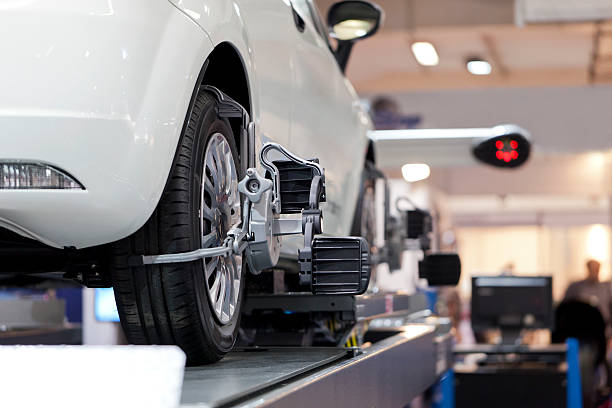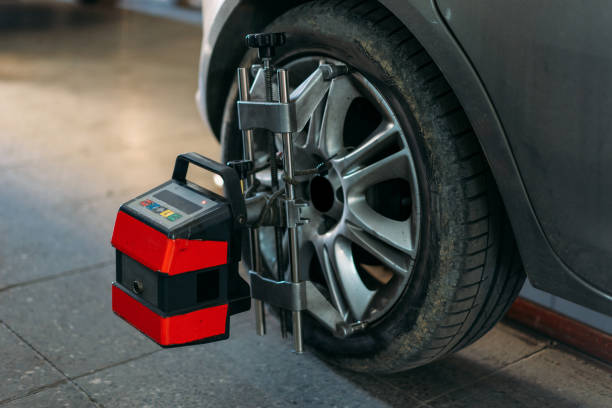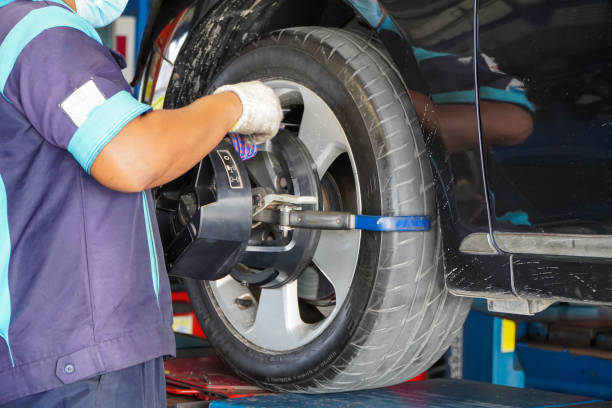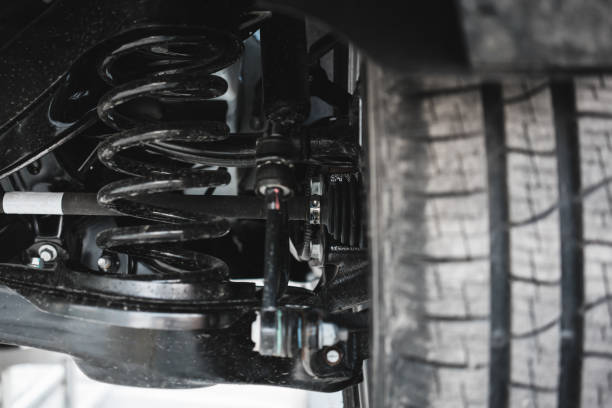As an experienced automobile enthusiast and engineer, I am excited to share insights into a crucial aspect of vehicle maintenance that directly impacts your driving experience and safety: proper wheel alignment. In this comprehensive guide, we will delve into the significance of wheel alignment, its effects on steering responsiveness, vehicle stability, and control. By the end of this article, you’ll understand how alignment plays a pivotal role in accident prevention and ensuring safer driving for you and your loved ones.
Top 10 Benefits of Proper Wheel Alignment
1. Improved Tire Lifespan and Cost Savings
Proper wheel alignment ensures that your tires wear evenly, reducing the risk of premature tire replacements. When your wheels are aligned correctly, your tires experience less unnecessary friction, leading to extended tread life and significant cost savings over time.
2. Enhanced Fuel Efficiency
A well-aligned vehicle experiences reduced rolling resistance, which means your engine doesn’t have to work as hard to move the car forward. This results in improved fuel efficiency, saving you money at the pump while also benefiting the environment.
3. Precise Steering and Handling
Maintaining proper wheel alignment guarantees that your vehicle responds accurately to steering inputs. This translates to a more controlled and stable driving experience, ensuring your safety and the safety of your passengers on the road.
4. Optimal Braking Performance
Aligned wheels contribute to evenly distributed braking forces across all tires. This results in shorter stopping distances and more effective braking, especially during sudden stops or emergency situations.
5. Reduced Vibrations and Noise
Misaligned wheels can lead to uncomfortable vibrations and excessive road noise. With precise wheel alignment, you’ll enjoy a smoother and quieter ride, enhancing your overall driving comfort.
6. Minimized Suspension Wear
Improper wheel alignment places added stress on suspension parts, potentially causing premature wear and tear. Proper alignment helps extend the lifespan of these components, saving you from costly repairs.
7. Enhanced Vehicle Stability
Well-aligned wheels contribute to better stability during cornering and lane changes. You’ll experience improved traction and reduced risk of skidding, especially on wet or slippery surfaces.
8. Prevention of Steering Drift
A vehicle with proper wheel alignment maintains straight-line stability, reducing the tendency to drift or pull to one side. This ensures a more relaxed and less fatiguing driving experience.
9. Alignment for All Road Conditions
Whether you’re navigating city streets or taking on rough terrains, well-aligned wheels provide optimal tire contact with the road, ensuring consistent performance across various driving conditions.
10. Long-Term Savings and Investment
While wheel alignment is a routine maintenance task, its benefits have a lasting impact on your vehicle’s overall health. By avoiding costly repairs and replacements through proper alignment, you’re making a wise investment in your vehicle’s longevity and reliability.
Unveiling the Connection Between Wheel Alignment and Steering Responsiveness
Understanding Wheel Alignment:
In the intricate dance of your vehicle’s components, wheel alignment takes center stage. It refers to the precise adjustment of the angles at which your wheels meet the road – camber, caster, and toe. This meticulous alignment ensures that your tires make optimal contact with the pavement.
Elevating Steering Responsiveness:
Imagine your car responding effortlessly to the subtlest touch of your steering wheel. Proper wheel alignment is the secret behind this exhilarating experience. When your wheels are aligned correctly, the vehicle’s handling becomes incredibly responsive. The harmonious interplay of components translates into smooth cornering and effortless maneuverability.
The Ripple Effect of Misalignment on Vehicle Stability and Control
The Deleterious Effects of Misalignment:
Allow me to draw from my experience as an automobile engineer: misalignment wreaks havoc on your driving dynamics. Even a slight misalignment can set off a chain reaction of issues. Uneven tire wear, drifting to one side, and vibrations in the steering wheel are telltale signs of misalignment.
Compromised Vehicle Stability:
Misalignment isn’t just an inconvenience; it compromises your vehicle’s stability. Your car might feel like it’s pulling to one side or resisting your attempts to stay in a straight line. These disturbances aren’t merely annoying; they can compromise your ability to control the vehicle, especially in emergency situations.
Safeguarding Lives through Proper Alignment
Alignment: The Unsung Hero of Accident Prevention:
Now, let’s discuss a topic that truly underscores the importance of wheel alignment – accident prevention. Accidents often result from a combination of factors, and misalignment can be a silent contributor. In critical moments, your ability to maintain control can be the difference between safety and disaster.
Nurturing Safer Driving:
Picture yourself navigating through adverse weather conditions or unexpected obstacles. Proper wheel alignment significantly enhances your vehicle’s grip on the road, allowing you to confidently navigate challenging terrains.
Prolonged Tire Lifespan: The Art of Preserving Your Wheels
When it comes to getting the most out of your vehicle, ensuring a prolonged tire lifespan is a key consideration. Proper wheel alignment plays a pivotal role in achieving this goal. In this comprehensive guide, we’ll delve into the significance of wheel alignment in preventing uneven tire wear, dissect common tire wear patterns and their underlying causes, and back it all up with real-world examples and studies that highlight the undeniable impact of proper alignment on tire longevity.
The Importance of Wheel Alignment
What is Wheel Alignment? Wheel alignment, often referred to as tire alignment, is the precise adjustment of your vehicle’s suspension components that position the wheels at optimal angles. This adjustment ensures that your tires make proper contact with the road, leading to even wear and enhanced safety.
Balancing Tire Wear and Performance: Achieving the correct wheel alignment not only extends tire lifespan but also enhances overall vehicle performance. Proper alignment minimizes rolling resistance, leading to improved fuel efficiency and a smoother ride.
Decoding Tire Wear Patterns
Camber Wear Camber wear manifests as excessive wear on one side of the tire’s tread. This is often caused by improper alignment where the top of the tire tilts either inward (negative camber) or outward (positive camber). The result is uneven tire contact and accelerated wear.
Toe Wear Toe wear occurs due to misalignment of the front wheels, causing them to point slightly inward (toe-in) or outward (toe-out). Such misalignment leads to a scuffing effect on the tires, reducing their lifespan and overall performance.
Extending Tire Lifespan Through Alignment
Case Studies on Prolonged Tire Lifespan Study 1: A 5-Year Analysis In a comprehensive study conducted over five years, vehicles with regular wheel alignment demonstrated a tire lifespan increase of up to 25%. This significant extension in tire life resulted in substantial cost savings for vehicle owners.
Fleet Management Findings A fleet management company observed a 15% decrease in tire replacement frequency after implementing a rigorous wheel alignment regimen. The cost savings and reduced environmental impact underscored the importance of proper alignment.
Long-term Cost Savings: The Hidden Benefits of Proper Wheel Alignment
s an experienced automobile enthusiast and expert in automobile engineering, I can’t stress enough the importance of proper wheel alignment. Beyond the immediate benefits of a smoother ride and enhanced handling, maintaining accurate wheel alignment can have a profound impact on your long-term finances. In this comprehensive guide, we’ll delve into the potential costs of neglecting wheel alignment, compare the expenses with regular maintenance, and provide you with practical tips to maximize your savings.
The Price of Neglecting Wheel Alignment
Tire Troubles and Uneven Wear
One of the most noticeable effects of ignoring wheel alignment is uneven tire wear. Improper alignment puts unnecessary strain on tires, causing them to wear unevenly and prematurely. This not only leads to the inconvenience of frequent tire replacements but also increases your long-term tire expenses.
Suspension Woes and Repairs
Neglected wheel alignment takes a toll on your vehicle’s suspension system. Misaligned wheels can lead to worn-out suspension components, including shocks and struts. These repairs can be not only expensive but also affect your vehicle’s overall performance and safety.
The Economics of Regular Alignment Maintenance
Longevity of Tire Life
By investing in regular wheel alignment, you’re essentially extending the lifespan of your tires. Proper alignment ensures that the tires wear evenly, which means you won’t need to replace them as frequently. This translates to significant savings in the long run.
Improved Fuel Efficiency
Believe it or not, proper wheel alignment contributes to better fuel efficiency. Misaligned wheels create uneven resistance, forcing your vehicle’s engine to work harder and consume more fuel. With regular alignment, you’ll save on gas expenses over time.
Practical Tips for Maximizing Savings
Routine Alignment Check-ups
Make it a habit to schedule alignment check-ups as part of your regular vehicle maintenance routine. By catching alignment issues early, you can prevent more extensive and costly damages down the road.
Invest in Professional Expertise
When it comes to wheel alignment, seeking professional expertise is paramount. Trust certified mechanics who specialize in alignment to ensure accurate adjustments and proper calibration.
Stay Mindful of Driving Habits
Your driving habits play a role in maintaining proper alignment. Avoid potholes, rough terrain, and curbs whenever possible to prevent unnecessary strain on your wheels and suspension.
Optimized Vehicle Performance Through Precise Wheel Alignment
In the world of automobile engineering, achieving peak performance goes beyond just the engine and horsepower. Proper wheel alignment plays a pivotal role in unlocking the full potential of your vehicle. It’s not just about aesthetics; it’s about the harmonious interaction between various components that can significantly impact your driving experience.
The Power of Proper Wheel Alignment
Unveiling the Hidden Impact When it comes to vehicle performance, what meets the eye is often just the tip of the iceberg. Proper wheel alignment, though seemingly minor, can unleash a cascade of benefits that reverberate throughout your driving journey.
The Alignment-Performance Connection Imagine your vehicle as a symphony, where each instrument (component) must play in harmony to create beautiful music (performance). Wheel alignment ensures this symphony, optimizing steering response, tire wear, fuel efficiency, and overall stability.
Alignment Angles and Suspension Dynamics
Caster – The Steering Stance Caster angle, the forward or rearward tilt of the steering axis, is like your vehicle’s posture. A proper caster angle enhances stability, promotes straight-line tracking, and reduces steering effort, ensuring a controlled and confident drive.
Camber – Embracing the Road Camber angle, the tilt of the wheel in relation to the road, is your vehicle’s way of hugging the pavement. Appropriate camber promotes even tire wear, maximizes tire-road contact, and sharpens cornering performance, allowing you to take on curves with precision.
Toe – The Fine Balance Toe alignment, the angle at which your tires point inward or outward when viewed from above, is all about balance. Optimal toe settings prevent tire scrub, reduce rolling resistance, and prevent unnecessary friction, thereby enhancing fuel efficiency and tire longevity.
Realizing Performance Gains Through Alignment
A Personal Journey to Enhanced Performance Picture this: a vehicle that used to veer slightly to one side, forcing constant steering adjustments. After a professional wheel alignment, the same vehicle cruises effortlessly down the road, devouring miles with newfound efficiency. This is the tangible transformation that alignment brings.
Expert Insights on Alignment-Driven Performance Automobile engineers and seasoned mechanics have a common refrain – wheel alignment is the unsung hero of performance optimization. Countless instances stand testament to alignment’s magical touch, where vehicles once sluggish and unwieldy become responsive, agile, and fuel-efficient machines.
Reduced Vibrations and Noise: The Crucial Role of Wheel Alignment in Automobile Care
Proper wheel alignment plays a crucial role in reducing vibrations and noise, ensuring a smooth and enjoyable ride for drivers and passengers alike. In this comprehensive guide, we’ll delve into the significance of wheel alignment, its impact on vibrations and noise, and real-life examples showcasing the difference it makes.
Understanding the Role of Wheel Alignment
1. What is Wheel Alignment? Wheel alignment refers to the precise positioning of a vehicle’s wheels in relation to each other and the road surface. It involves adjusting three primary angles: camber, toe, and caster. Correct wheel alignment ensures that the tires make optimal contact with the road, promoting even tire wear and a balanced ride.
2 The Importance of Proper Wheel Alignment Proper wheel alignment is not merely a matter of convenience; it directly influences the vehicle’s overall performance and safety. When the wheels are misaligned, various issues arise that affect both the driver and the vehicle.
How Misalignment Contributes to Discomfort and Potential Vehicle Issues
1 Uneven Tire Wear Misalignment causes tires to wear unevenly, leading to premature tire replacement and increased maintenance costs.
2 Vibrations and Steering Wheel Shimmy Misaligned wheels can create annoying vibrations and an unsettling steering wheel shimmy, which hampers the driving experience.
3 Reduced Fuel Efficiency When wheels are misaligned, the vehicle experiences increased rolling resistance, leading to reduced fuel efficiency and increased emissions.
4 Safety Concerns Misalignment affects the vehicle’s handling and stability, compromising safety, especially during emergency maneuvers.
The Impact of Wheel Alignment on Noise Reduction
1 Tire Noise Reduction Proper wheel alignment minimizes tire noise by ensuring even contact between the tires and the road, reducing the chances of tire “howling” or excessive road noise.
2 Suspension Noise Reduction Misalignment can strain the vehicle’s suspension system, leading to squeaks, clunks, and rattles. Correct alignment eliminates these noises, providing a quieter and more pleasant ride.
Real-Life Examples of Reduced Vibrations and Noise Post-Alignment
1 Example 1: The Family Road Trip Before wheel alignment, the Smith family experienced a bumpy and noisy ride during their road trip. After getting their wheels aligned, the vibrations reduced significantly, and the cabin noise dropped noticeably, making the journey more comfortable and enjoyable.
2 Example 2: The Commuter’s Delight A busy professional, John, used to dread his daily commute due to the constant vibrations and road noise in his car. After a wheel alignment service, he felt a remarkable difference, with smoother driving and a quieter cabin environment, making his daily drive a delight.
Wheel alignment is a fundamental aspect of automobile care and engineering that significantly impacts vibrations and noise. By addressing misalignment, drivers can experience a smoother, quieter, and more enjoyable ride, all while ensuring their safety and extending the lifespan of their tires. Regular alignment checks and maintenance are essential to optimize performance and enhance the driving experience. Embrace proper wheel alignment, and you’ll embark on a journey of reduced vibrations and noise, making your time on the road more pleasant and stress-free.
Elimination of Drifting and Pulling: Achieving Stability through Alignment
In the world of automobile care and engineering, the issue of drifting and pulling in vehicles can be a frustrating and potentially dangerous problem. These problems are often closely connected to misalignment, where the wheels do not have the proper orientation to the vehicle’s frame. Misalignment can lead to uneven tire wear, reduced fuel efficiency, and compromised handling. As an expert in automobile engineering, I will guide you through the process of identifying and eliminating alignment-related drifting issues, ensuring improved stability and safety on the road.
Understanding Drifting and Pulling
1. What is Drifting? Drifting refers to the phenomenon where a vehicle veers off its intended path without driver input. This deviation from the straight trajectory can occur gradually or suddenly, making it challenging for drivers to maintain control.
2. What is Pulling? Pulling occurs when a vehicle tends to veer to one side consistently, even when the steering wheel is held steady. It can manifest as either left or right pulling, depending on the misalignment direction.
3. The Link to Misalignment Both drifting and pulling issues are commonly caused by misalignment. Misalignment can result from various factors, such as hitting potholes, curb impacts, worn suspension components, or even simple wear and tear over time.
Diagnostic Tips for Identifying Alignment-Related Drifting
1. Visual Inspection Perform a visual inspection of the vehicle’s tires, looking for signs of uneven wear, such as excessive wear on one side or feathering along the edges.
2. Test Drive Analysis Take the vehicle for a test drive on a flat and straight road. Pay attention to how the vehicle behaves when you release the steering wheel momentarily. If it drifts to one side, misalignment may be the culprit.
3. Steering Wheel Alignment While driving on a level road, ensure that the steering wheel is centered. If it is off-center even when driving straight, this indicates alignment issues.
4. Tire Pressure Check Verify that all tires are inflated to the recommended pressure levels. Improper tire pressure can lead to irregular tire wear, mimicking alignment-related drifting.
Success Stories of Improved Stability through Alignment
Case Study 1: Minivan Overcoming Drifting Issues A family’s minivan was experiencing consistent drifting to the right. After a professional alignment service, the misalignment was corrected. The family noticed a significant improvement in handling and reduced tire wear, making their long road trips much safer and enjoyable.
Case Study 2: Sports Car Regaining Precision Handling A sports car enthusiast complained of drifting during sharp turns and diminished handling response. The alignment experts identified misaligned front wheels as the root cause. After precise adjustments, the car’s steering responsiveness and cornering stability were remarkably restored, enhancing the driver’s confidence on the track.
FAQs on Benefits of Proper Wheel Alignment
As an expert in automobile care and engineering, I understand the importance of proper wheel alignment for your vehicle’s performance, safety, and overall longevity. In this comprehensive guide, I will address the most frequently asked questions about wheel alignment and shed light on the benefits it brings to your vehicle.
1. What is Wheel Alignment and Why is it Important?
Wheel alignment refers to the precise adjustment of the angles at which your vehicle’s wheels make contact with the road. Correct alignment ensures that all four wheels are parallel and perpendicular to the ground, optimizing the way your vehicle handles and improving tire wear.
2. How Does Wheel Alignment Impact Tire Life?
Proper wheel alignment significantly extends the lifespan of your tires. When your wheels are aligned correctly, the tires wear evenly, preventing premature wear on the edges, which can occur with misalignment. This not only saves you money on tire replacements but also enhances road grip and handling.
3. Can Wheel Alignment Improve Fuel Efficiency?
Yes, absolutely! When your wheels are properly aligned, your vehicle encounters less resistance from the road surface. As a result, the engine doesn’t have to work as hard to propel the car forward, leading to improved fuel efficiency and ultimately saving you money at the gas pump.
4. Does Wheel Alignment Enhance Vehicle Handling and Safety?
Correct wheel alignment has a direct impact on your vehicle’s handling and safety. When all four wheels are in sync, your car drives straight, and you have better control during cornering and braking. This improves overall stability and reduces the risk of accidents, especially during emergency maneuvers.
5. How Can I Tell If My Vehicle Needs Wheel Alignment?
There are several signs that your vehicle may require a wheel alignment:
- Uneven or rapid tire wear
- Drifting to one side when driving straight
- Vibrations in the steering wheel
- Steering wheel not centered when driving straight
- Squealing tires
6. How Often Should I Get My Wheels Aligned?
It is recommended to have your wheels aligned at least once a year or every 10,000 to 12,000 miles, whichever comes first. However, certain driving conditions, such as hitting potholes or curbs, might necessitate more frequent alignment checks.
7. Can I Perform Wheel Alignment Myself?
While there are DIY alignment kits available, it’s best to leave wheel alignment to professionals. Automobile service centers have specialized equipment and trained technicians who can accurately align your wheels, ensuring proper adjustments and precise angles.
8. Can Wheel Alignment Solve Steering Wheel Vibrations?
In some cases, yes. If the vibrations are caused by misaligned wheels, a proper alignment can resolve the issue. However, other factors like unbalanced tires or worn suspension components may also contribute to vibrations and should be checked by a qualified mechanic.
9. Does Wheel Alignment Impact All Vehicle Types Equally?
Yes, wheel alignment is crucial for all types of vehicles, including cars, trucks, SUVs, and even motorcycles. Proper alignment ensures optimal tire performance and handling characteristics, regardless of the vehicle type.
10. Is Wheel Alignment Covered by Vehicle Warranties?
Typically, wheel alignment falls under regular vehicle maintenance and is not covered by standard warranties. However, if your car is relatively new, it’s essential to follow the manufacturer’s maintenance schedule to keep your warranty intact and enjoy the long-term benefits of proper wheel alignment.











